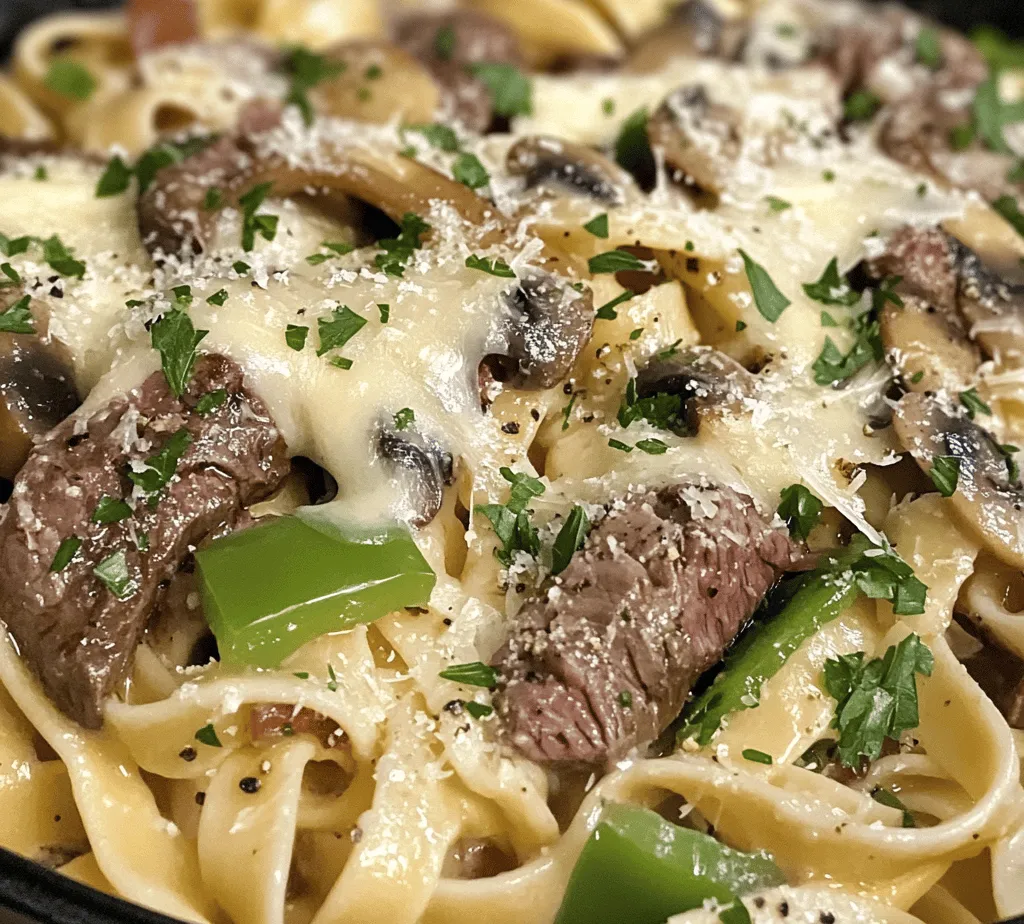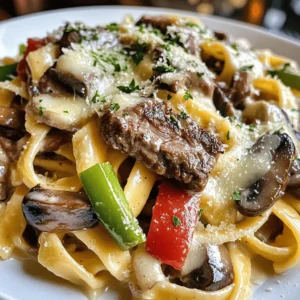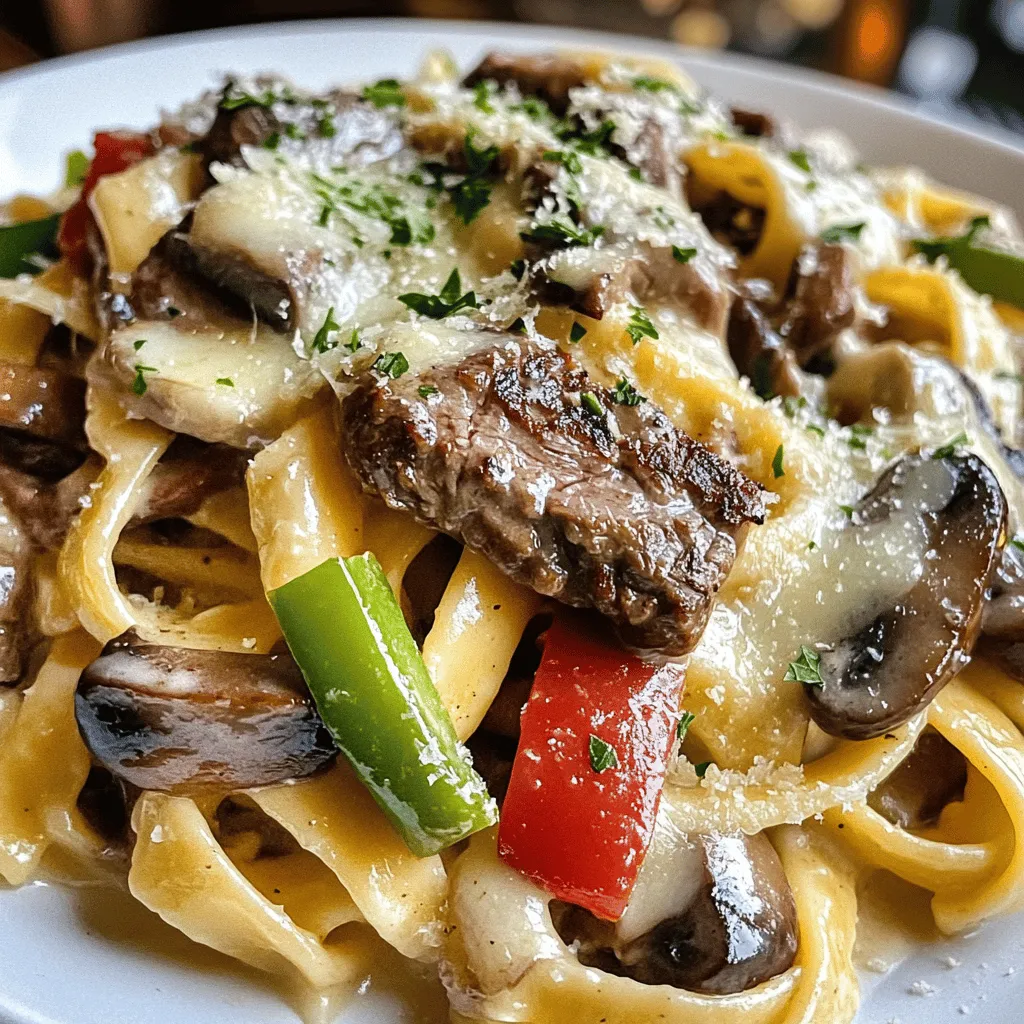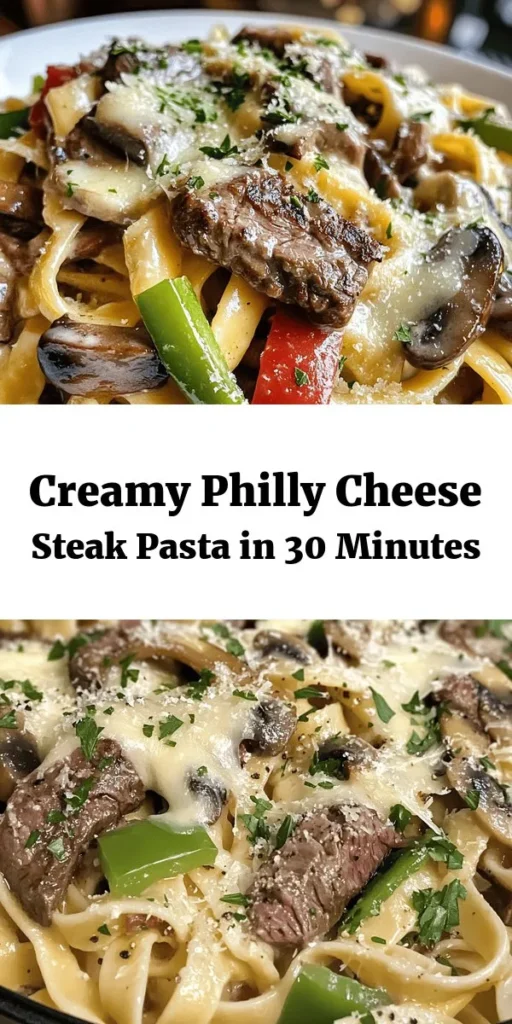Introduction to Philly Cheese Steak Pasta Delight
The Philly Cheese Steak Pasta Delight is an innovative culinary creation that marries the iconic flavors of the beloved Philly cheesesteak sandwich with the comforting texture of pasta. This dish offers a delightful twist that transforms the classic into a hearty, satisfying meal, perfect for both weeknight dinners and special occasions. The combination of tender beef, sautéed vegetables, creamy sauce, and gooey cheese makes this recipe a favorite for cheese lovers and pasta aficionados alike.
The origins of the Philly cheesesteak date back to the 1930s in Philadelphia, where it was first crafted by Pat and Harry Olivieri. This sandwich quickly gained popularity due to its mouthwatering combination of thinly sliced beefsteak and melted cheese, served in a freshly baked hoagie roll. Over the years, chefs and home cooks have experimented with the traditional recipe, leading to various interpretations, including the delicious pasta version we are about to explore.
In this article, we will delve into the essential ingredients that make up the Philly Cheese Steak Pasta Delight, provide a step-by-step guide for preparation, and highlight the unique flavor profile that sets this dish apart. With its simplicity and appeal, this recipe is sure to impress family and friends at your next gathering.
Understanding the Ingredients
To create a truly unforgettable Philly Cheese Steak Pasta Delight, it’s essential to understand the key components that contribute to its rich flavors and comforting texture. Here’s a closer look at the main ingredients you’ll need for this recipe.
Overview of Pasta Choices
When it comes to selecting the right pasta for this dish, there are several options that work well. Traditionally, a medium-sized pasta such as penne or rigatoni serves as an excellent base, allowing the creamy sauce and beef to cling beautifully. However, you can also experiment with other shapes like fusilli or rotini, which add a fun twist and enhance the overall presentation of the dish. The key is to choose a pasta that holds the sauce effectively while providing a satisfying bite.
Importance of Beef Sirloin
The star of the Philly Cheese Steak Pasta Delight is undoubtedly the beef sirloin. This cut of meat is known for its tenderness and rich flavor, making it the perfect choice for this recipe. When sliced thinly against the grain, beef sirloin cooks quickly and remains juicy, adding depth to the overall dish. Look for well-marbled beef, as the fat content enhances the flavor and ensures a succulent bite. For a leaner option, you may also consider flank steak or ribeye, but sirloin is the preferred choice for this recipe.
The Role of Aromatics: Onions, Bell Peppers, and Garlic
Aromatic vegetables play a crucial role in building flavor in the Philly Cheese Steak Pasta Delight. Onions and bell peppers are classic additions that provide sweetness and texture. When sautéed, they develop a caramelized flavor that complements the beef beautifully. Additionally, garlic adds a punch of flavor and aroma that elevates the dish to new heights. A combination of these aromatics not only enhances taste but also creates a delightful fragrance as they cook, making your kitchen feel inviting and warm.
Enhancing Flavor with Worcestershire and Soy Sauce
To amplify the umami notes in the dish, Worcestershire sauce and soy sauce are employed as flavor enhancers. Worcestershire sauce, with its complex blend of tangy and savory flavors, adds depth to the beef while soy sauce brings a touch of saltiness and richness. Together, these two ingredients work harmoniously to elevate the overall taste, ensuring that every bite is bursting with flavor. Use them sparingly, as a little goes a long way in transforming the dish.
The Creamy Base: Beef Broth and Heavy Cream
The creamy sauce that binds the dish together is made from a combination of beef broth and heavy cream. Beef broth adds a rich, savory base that infuses the dish with robust flavor, while heavy cream lends a luxurious, velvety texture. This combination creates a sauce that is both indulgent and comforting, enveloping the pasta and beef in creamy goodness. If you’re looking for a lighter version, you can substitute half-and-half or whole milk, but keep in mind that this will alter the richness of the final dish.
The Cheese Factor: Provolone and Parmesan
No Philly Cheese Steak is complete without cheese, and for this pasta dish, provolone and Parmesan are the perfect pair. Provolone, with its mild and creamy flavor, melts beautifully, creating that gooey cheese pull that everyone loves. Meanwhile, grated Parmesan adds a sharp, nutty note that complements the other flavors in the dish. When mixed together, these cheeses create a decadent topping that transforms the pasta into a cheesy delight. For those who prefer a stronger cheese flavor, consider adding some shredded mozzarella or even a sprinkle of cheddar for an extra kick.
The Garnishing Touch: Fresh Parsley
Finally, a sprinkle of fresh parsley not only adds a pop of color but also brings a refreshing brightness to the dish. The herb contrasts beautifully with the rich, savory flavors, balancing the overall profile. Fresh parsley is an excellent finishing touch, elevating the presentation and providing a hint of freshness that rounds out the dish perfectly.
Preparing the Dish
Now that we’ve covered the key ingredients, let’s dive into the preparation process. Making the Philly Cheese Steak Pasta Delight is straightforward and enjoyable, and it’s perfect for cooks of all skill levels. Follow these step-by-step instructions for a delicious outcome that will have everyone coming back for seconds.
Cooking the Pasta to Perfection
The first step in preparing this delightful dish is cooking the pasta. To achieve the best results, begin by bringing a large pot of salted water to a rolling boil. The salt not only flavors the pasta but also helps maintain its texture during cooking. Once the water is boiling, add your chosen pasta and stir gently to prevent sticking.
Best Practices for Boiling Pasta
As a general rule, refer to the package instructions for cooking times, but it’s advisable to taste the pasta a minute or two before the suggested time is up. This will allow you to achieve the perfect al dente texture, which means the pasta should be cooked through but still have a slight firmness when bitten. Overcooked pasta can become mushy and will not hold up well when combined with the sauce.
Importance of Al Dente Texture
Cooking the pasta al dente is crucial for this recipe, as it will continue to cook slightly once combined with the hot sauce. This ensures that the pasta retains its shape and texture, providing a satisfying bite in every forkful. Once the pasta is cooked to your liking, drain it in a colander, reserving a cup of the pasta water for later use. This starchy water can be added to the sauce if you need to thin it out, ensuring the perfect consistency.
Sautéing the Beef for Optimal Flavor
While the pasta is cooking, it’s time to focus on the beef. Start by slicing the beef sirloin against the grain into thin strips. This technique ensures tenderness, allowing for a melt-in-your-mouth experience. Once sliced, season the beef strips generously with salt and pepper to enhance their natural flavor.
Choosing the Right Temperature
In a large skillet or frying pan, heat a tablespoon of olive oil over medium-high heat. Once the oil is shimmering but not smoking, carefully add the seasoned beef to the pan. It’s essential not to overcrowd the pan, as this will cause the meat to steam rather than sear. If necessary, cook the beef in batches to achieve a nice golden-brown crust.
Seasoning Techniques for Beef
As the beef cooks, use a wooden spoon to stir occasionally, ensuring even cooking. The goal is to achieve a nice sear on the beef, which will add depth to the overall flavor. Once the beef is cooked to medium rare (about 3-4 minutes), remove it from the pan and set it aside. The residual heat will continue cooking the beef slightly while you prepare the vegetables.
Sautéing Vegetables for Flavor and Texture
With the beef set aside, it’s time to sauté the vegetables. In the same skillet, add a bit more olive oil if necessary, and toss in the sliced onions and bell peppers. The fond left in the pan from the beef will add extra flavor to the vegetables, making them taste even better.
Timing and Techniques for Perfectly Cooked Vegetables
Sauté the onions and bell peppers over medium heat for about 5-7 minutes until they are soft and beginning to caramelize. Stir occasionally to prevent burning. If you prefer your vegetables with a bit of crunch, you can cook them for a shorter time, adjusting to your personal preference.
The Importance of Garlic in the Sauté Process
When the onions and peppers are nearly done, add minced garlic and cook for an additional minute. Garlic cooks quickly and will become bitter if overcooked, so be sure to watch it closely. The aroma of sautéing garlic will fill your kitchen and signal that it’s time to combine the flavors.
Combining Ingredients for a Flavorful Sauce
Once the vegetables are cooked, return the sautéed beef to the skillet, mixing everything together. Next, pour in the beef broth and bring the mixture to a simmer. This allows the flavors to meld beautifully. Then, gradually stir in the heavy cream, creating a rich and creamy sauce. If the sauce appears too thick, add a splash of the reserved pasta water until you reach your desired consistency.
Afterward, sprinkle in Worcestershire sauce and soy sauce, stirring to incorporate. Taste the sauce and adjust seasoning as needed, adding more salt, pepper, or sauces to suit your preference. Finally, add the cooked pasta to the skillet, tossing everything together until the pasta is well coated in the creamy sauce.
With the preparation steps complete, the Philly Cheese Steak Pasta Delight is ready to shine as the centerpiece of your next meal. The combination of flavors, textures, and aromas will undoubtedly leave a lasting impression on everyone fortunate enough to enjoy it. In the next part of this article, we’ll explore some tips for achieving the best results and answer common questions about this delicious dish.

How to Achieve the Right Consistency
To ensure your Philly Cheese Steak Pasta Delight has the perfect texture, consistency plays a crucial role. The sauce should be creamy and cling to the pasta without being watery or overly thick. Start by gradually adding your liquid ingredients, such as beef broth or cream, to the pan while stirring. This allows you to monitor the sauce’s thickness and adjust it as needed. Aim for a velvety sauce that coats the pasta well, offering a satisfying mouthfeel with each bite.
If you find that your sauce is too thick, simply add a splash of pasta water — the starchy liquid can help loosen it without diluting the flavor. Conversely, if it’s too runny, let it simmer for a few extra minutes to reduce and thicken. Remember to taste as you go, allowing the flavor and texture to develop harmoniously.
Balancing Flavor with Seasoning Adjustments
Seasoning is crucial in achieving a well-balanced flavor profile for your Philly Cheese Steak Pasta. While the ingredients themselves contribute to the overall taste, the right seasoning can elevate the dish. Start with a base of salt and pepper, and consider adding garlic powder, onion powder, or smoked paprika for depth.
As you cook, taste frequently. If the dish feels flat, a dash of Worcestershire sauce or a hint of hot sauce can add complexity and richness. Freshly chopped parsley or oregano can provide freshness and contrast to the creamy sauce. Always remember that seasoning should enhance, not overpower, the natural flavors of the ingredients. Adjusting seasoning at different stages of cooking allows you to tailor the dish to your personal taste preferences.
Melting Cheese for Creamy Perfection
The cheese is a star ingredient in this dish, so achieving the right melt is essential for that creamy perfection. Use a combination of cheeses for the best results. A classic option is provolone, which melts beautifully, along with cream cheese for added creaminess and richness.
When adding cheese to the sauce, do so gradually and at a lower heat to prevent it from becoming rubbery. Stir continuously as the cheese melts, ensuring it blends seamlessly into the sauce. If you prefer a sharper flavor, consider adding some grated Parmesan cheese toward the end of cooking. This adds a delightful tang and depth to the overall taste.
Techniques for Incorporating Cheese into the Sauce
Incorporating cheese into your sauce can be done effectively by following a few techniques. First, ensure your sauce is heated but not boiling when you add the cheese; high temperatures can cause the cheese to seize up. Gradually stir in the cheese, allowing it to melt before adding more. This prevents clumps and ensures a smooth, creamy texture.
For an extra layer of flavor, consider reserving a small amount of cheese to sprinkle on top of the dish just before serving. This not only enhances the visual appeal but also adds a fresh burst of flavor as you take your first bite.
The Importance of Temperature Control
Temperature control is vital when creating a creamy sauce for your Philly Cheese Steak Pasta. If your sauce is too hot, the cheese can break and become greasy, while a sauce that is not hot enough won’t melt the cheese properly. Maintain a medium-low heat throughout the cooking process, adjusting as needed to keep the sauce at a steady simmer.
If you find your sauce is cooling too quickly, consider placing a lid on the pan for a few moments to retain heat without overcooking. This careful control ensures that the flavors meld beautifully without compromising the texture of the sauce.
Mixing Pasta with the Sauce
Once your sauce is ready, it’s time to combine it with the pasta. Start by cooking your pasta until it is al dente, as it will continue to cook slightly once mixed with the sauce. Drain the pasta, reserving a cup of the pasta water to adjust the sauce’s consistency if needed.
In a large skillet or pot, add the cooked pasta to the sauce. Use tongs or a large spoon to gently toss the pasta with the sauce, ensuring every piece is well coated. This step is essential for creating a cohesive dish where the flavors meld beautifully. If the sauce appears too thick at this stage, add a splash of the reserved pasta water to loosen it up.
Ensuring Even Coating of Pasta
To ensure that each piece of pasta is evenly coated with the delicious sauce, follow a few key techniques. First, add the pasta to the sauce rather than the other way around. This allows the pasta to absorb the flavors directly from the sauce.
Toss the pasta with the sauce gently but thoroughly, ensuring that every strand is covered. If you notice that some pasta pieces are clumped together, use your tongs to separate them while mixing. The goal is to achieve a beautiful, cohesive dish where every bite is infused with flavor.
Techniques for Reheating Without Overcooking
If you have leftovers or need to reheat your Philly Cheese Steak Pasta, it’s crucial to do so without overcooking the pasta or sauce. The best method is to use a stovetop pan over low heat. Add a splash of milk or broth to help loosen the sauce and prevent it from sticking to the pan. Stir frequently, allowing the pasta to heat evenly.
Avoid using a microwave if possible, as it can lead to uneven heating and rubbery pasta. If you must use a microwave, do so in short increments, stirring in between, and cover the dish to retain moisture. This method helps maintain the dish’s creamy texture while ensuring it is warmed through.
Serving Suggestions
Creating the Perfect Presentation for Your Dish
Presentation matters, especially when serving a dish as hearty and comforting as Philly Cheese Steak Pasta. Start with a large serving bowl or individual plates, depending on your preference. For a family-style presentation, consider a large, deep dish that showcases the pasta’s creamy sauce and colorful ingredients.
For individual servings, use shallow bowls that allow the dish to spread out, making it visually appealing. The creamy sauce should glisten, and the toppings should be visible, enticing your guests with the dish’s rich and hearty nature.
Ideal Serving Sizes and Portions
For serving sizes, a standard portion of pasta is typically about 1 to 1.5 cups per person, depending on whether you are serving it as a main dish or alongside other courses. If you plan to serve additional sides — such as a salad or bread — consider reducing the portion size slightly to accommodate.
Having a measured serving size also helps in managing dietary needs and offers a more refined dining experience. If you’re unsure, consider starting with smaller portions, allowing guests to ask for seconds if desired.
Garnishing Ideas with Fresh Herbs
A simple garnish can elevate your dish, so consider adding fresh herbs for a pop of color and flavor. Chopped parsley is a classic choice, offering a fresh, vibrant contrast to the creamy pasta. Additionally, fresh basil or chives can provide a delightful aroma and flavor.
Sprinkle the herbs generously over the top just before serving. This not only enhances the visual appeal but also adds a fresh element that cuts through the richness of the dish.
Pairing Suggestions: Complementary Sides and Drinks
Complement your Philly Cheese Steak Pasta with sides that enhance the meal without overpowering it. A crisp, refreshing salad with a tangy vinaigrette can provide a lovely counterbalance to the richness of the pasta. Roasted vegetables or a light garlic bread can also be excellent accompaniments.
When it comes to beverages, consider pairing this dish with a light-bodied red wine, such as Pinot Noir, which complements the beef flavors beautifully. For non-alcoholic options, a sparkling water with a squeeze of lemon can cleanse the palate nicely.
Creative Serving Options: Individual Plates vs. Family Style
Deciding between individual plates and family-style serving can impact the dining experience. Individual plates allow for a more formal presentation and can be easier for serving guests. Family-style serving, on the other hand, encourages sharing and interaction, creating a relaxed atmosphere.
If hosting a casual gathering, consider serving in a large bowl and allowing guests to help themselves. For more formal occasions, plating each dish individually with a thoughtful garnish can impress your guests and showcase the effort put into the meal.
Nutritional Considerations
Analyzing the Health Aspects of Philly Cheese Steak Pasta
While Philly Cheese Steak Pasta is undoubtedly delicious, being aware of its nutritional profile is essential. A typical serving contains significant amounts of carbohydrates from the pasta, protein from the beef and cheese, and fats from the creamy sauce.
To provide a more balanced meal, consider incorporating vegetables into the dish, such as bell peppers and onions, which add nutrients and fiber. This not only enhances the flavor but also boosts the dish’s health benefits.
Breakdown of Key Nutritional Components
A standard serving of Philly Cheese Steak Pasta typically includes:
– Calories: Approximately 600-800 calories, depending on portion size and ingredients used.
– Protein: Around 30-40 grams, primarily from beef and cheese.
– Carbohydrates: Roughly 60-70 grams, mostly from pasta.
– Fats: About 25-35 grams, varying based on cheese and cream content.
Taking these nutritional components into account can help you manage your dietary goals while enjoying this rich and satisfying dish.
Balancing Richness with Health-Conscious Choices
If you want to enjoy this dish while being mindful of calorie intake, consider making a few adjustments. Use whole wheat pasta for added fiber and nutrients, and opt for lean cuts of beef, such as sirloin or flank steak. Additionally, using low-fat cheese or reducing the amount of cream can significantly decrease the overall fat content while still maintaining a rich flavor.
Tips for Modifying Ingredients for Dietary Needs
For those with dietary restrictions or preferences, modifying the recipe is simple. For gluten-free options, swap traditional pasta with gluten-free alternatives made from rice or chickpeas. If you’re looking for a vegetarian option, consider replacing beef with sautéed mushrooms or a meat substitute, ensuring the flavors remain robust.
Vegetarian Alternatives
To create a vegetarian version of this dish, incorporate hearty vegetables such as mushrooms, zucchini, and bell peppers. These can be sautéed until tender and added to the sauce in place of beef. You can also consider using plant-based cheese to maintain creaminess without dairy.
Lower-Calorie Substitutes
For a lighter version of Philly Cheese Steak Pasta, consider using cauliflower pasta, which significantly reduces the carbohydrate content while still providing a satisfying texture. Additionally, substituting Greek yogurt for cream can add creaminess without the extra calories, keeping the dish delicious and nutritious.
Conclusion
Philly Cheese Steak Pasta Delight is not just a meal; it is an experience that brings together robust flavors, satisfying textures, and a sense of comfort. With its straightforward preparation and rich taste, it stands as an ideal choice for both busy weeknights and festive gatherings. This recipe showcases the beauty of combining diverse culinary elements into a single dish, making it a staple for any home cook looking to impress. Enjoy the journey of creating this delightful dish, and savor each bite of your culinary creation.



